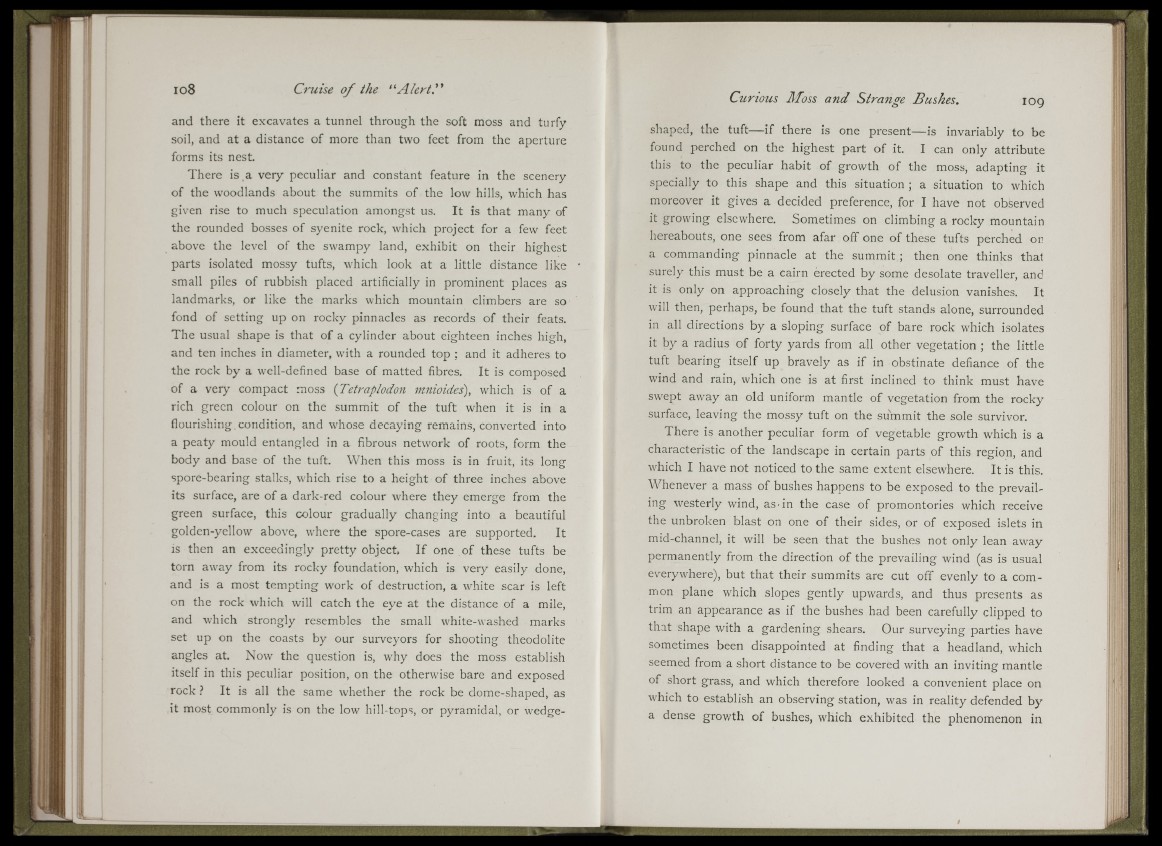
upi
m
"3!
"Il
108
It!!!
and there it excavates a tunnel through the soft moss and turfy
soil, and at a distance of more than two feet from the aperture
forms its nest.
There is a very peculiar and constant feature in the scenery
of the woodlands about the summits of the low hills, which has
given rise to much speculation amongst us. It is that many of
the rounded bosses of syenite rock, which project for a few feet
above the level of the swampy land, exhibit on their highest
parts isolated mossy tufts, which look at a little distance like
small piles of rubbish placed artificially in prominent places as
landmarks, or like the marks which mountain climbers are so
fond of setting up on rocky pinnacles as records of their feats.
The usual shape is that of a cylinder about eighteen inches high,
and ten inches in diameter, with a rounded top ; and it adheres to
the rock by a well-defined base of matted fibres. It is composed
of a very compact moss {Tetraplodon mnioides), which is of a
rich green colour on the summit of the tuft when it is in a
flourishing condition, and whose decaying remains, converted into
a peaty mould entangled in a fibrous network of roots, form the
body and base of the tuft. When this moss is in fruit, its long
spore-bearing stalks, which rise to a height of three inches above
its surface, are of a dark-red colour where they emerge from the
green surface, this colour gradually changing into a beautiful
golden-yellow above, where the spore-cases are supported. It
is then an exceedingly pretty object. If one of these tufts be
torn away from its rocky foundation, which is very easily done,
and is a most tempting work of destruction, a white scar is left
on the rock which will catch the eye at the distance of a mile,
and which strongly resembles the small white-washed marks
set up on the coasts by our surveyors for shooting theodolite
angles at. Now the question is, why does the moss establish
itself in this peculiar position, on the otherwise bare and exposed
rock .? It is all the same whether the rock be dome-shaped, as
it most commonly is on the low hill-tops, or pyramidal, or wedgeshapcd,
the tuft— if there is one present— is invariably to be
found perched on the highest part of it. I can only attribute
this to the peculiar habit of growth of the moss, adapting it
specially to this shape and this situation ; a situation to which
moreover it gives a decided preference, for I have not observed
it growing elsewhere. Sometimes on climbing a rocky mountain
hereabouts, one sees from afar off one of these tufts perched 011
a commanding pinnacle at the summit ; then one thinks thaï
surely this must be a cairn erected by some desolate traveller, and
it is only on approaching closely that the delusion vanishes. It
will then, perhaps, be found that the tuft stands alone, surrounded
in all directions by a sloping surface of bare rock which isolates
it by a radius of forty yards from all other vegetation ; the little
tuft bearing itself up bravely as if in obstinate defiance of the
wind and rain, which one is at first inclined to think must have
swept away an old uniform mantle of vegetation from the rocky
surface, leaving the mossy tuft on the summit the sole survivor.
There is another peculiar form of vegetable growth which is a
characteristic of the landscape in certain parts of this region, and
which I have not noticed to the same extent elsewhere. It is this.
Whenever a mass of bushes happens to be exposed to the prevailing
westerly wind, as.in the case of promontories which receive
the unbroken blast on one of their sides, or of exposed islets in
mid-channel, it will be seen that the bushes not only lean away
permanently from the direction of the prevailing wind (as is usual
everywhere), but that their summits are cut off evenly to a common
plane which slopes gently upwards, and thus presents as
trim an appearance as if the bushes had been carefully clipped to
that shape with a gardening shears. Our surveying parties have
sometimes been disappointed at finding that a headland, which
seemed from a short distance to be covered with an inviting mantle
of short grass, and which therefore looked a convenient place on
which to establish an observing station, was in reality defended by
a dense growth of bushes, which exhibited the phenomenon in
■m'-1
fef':